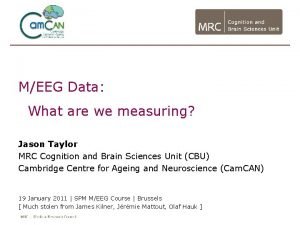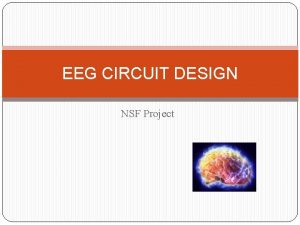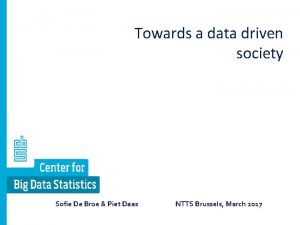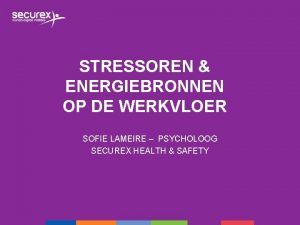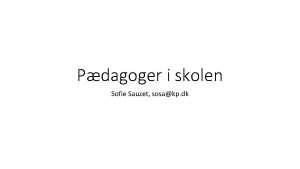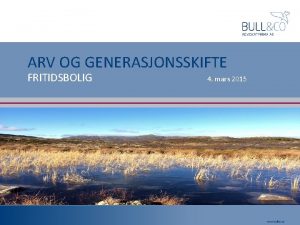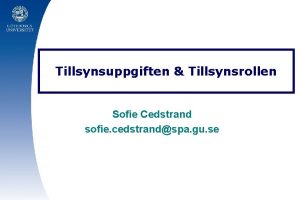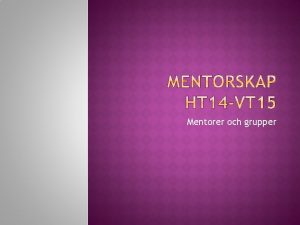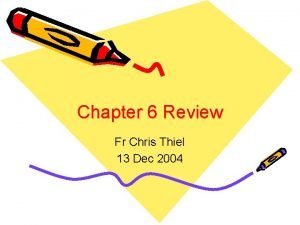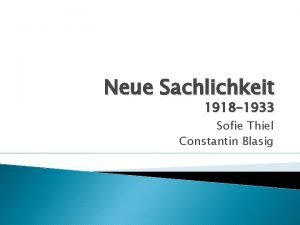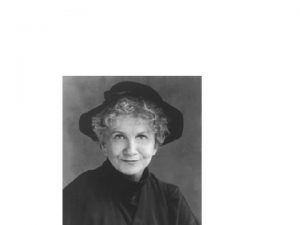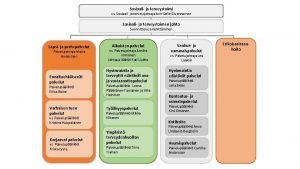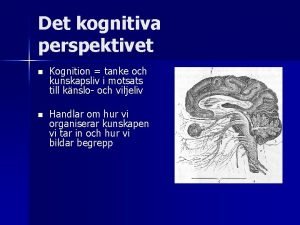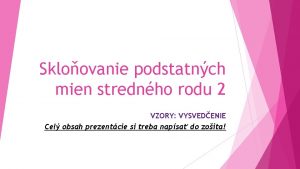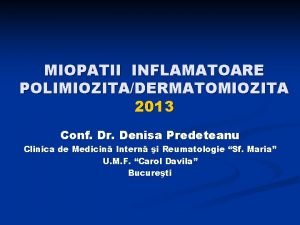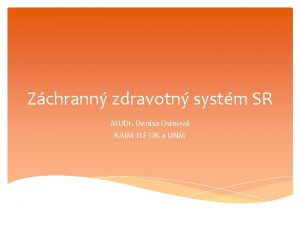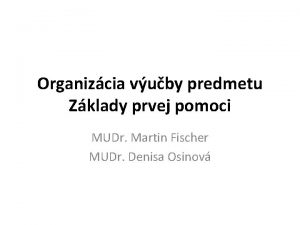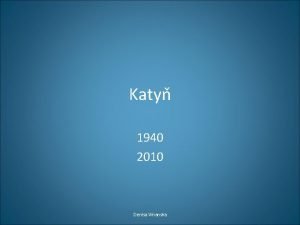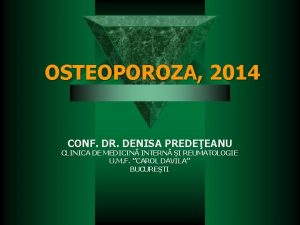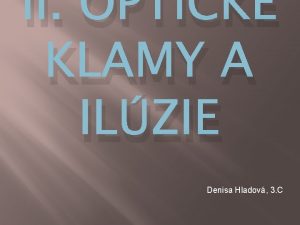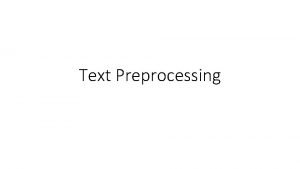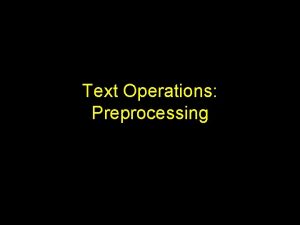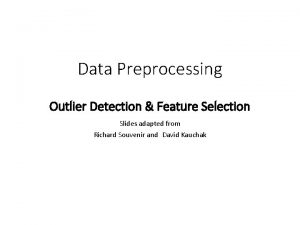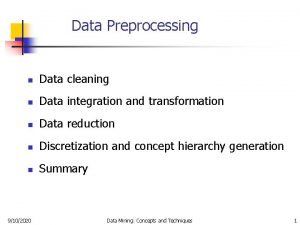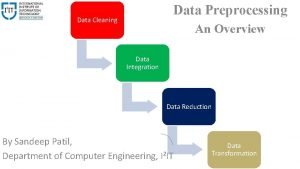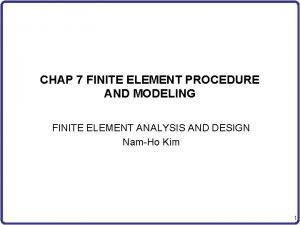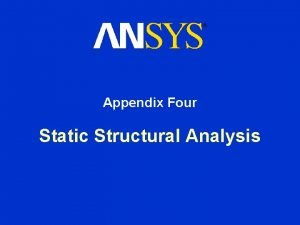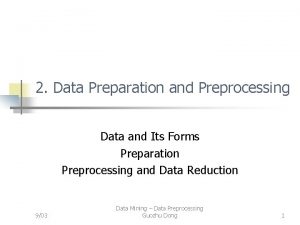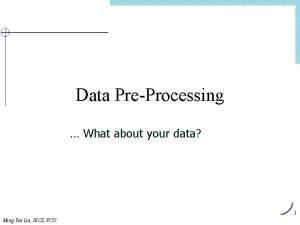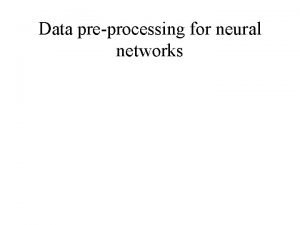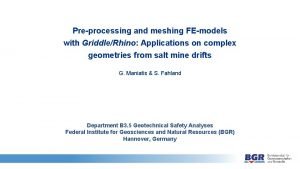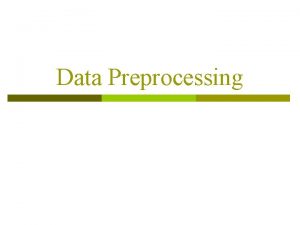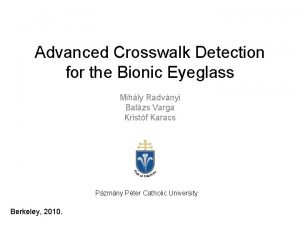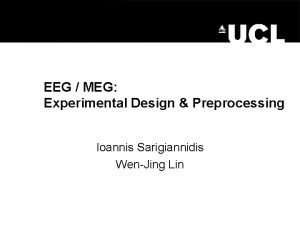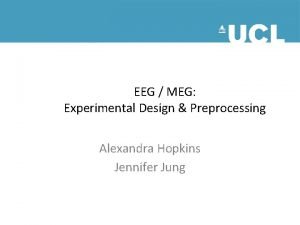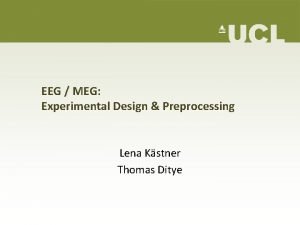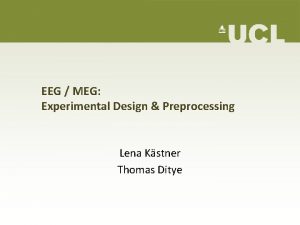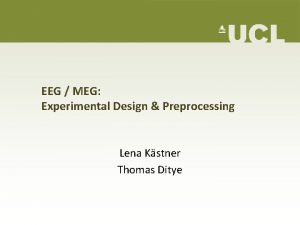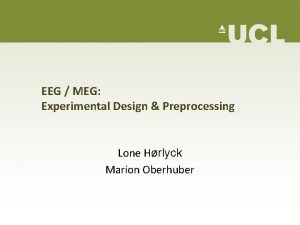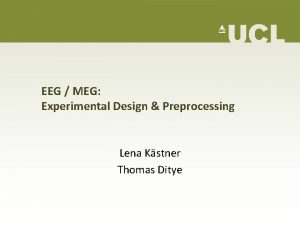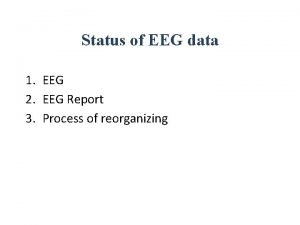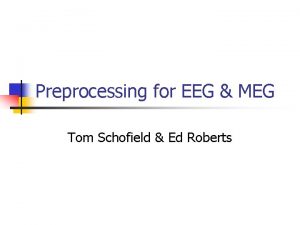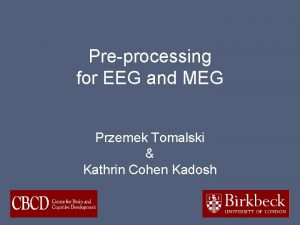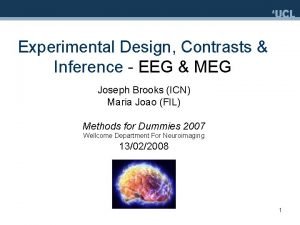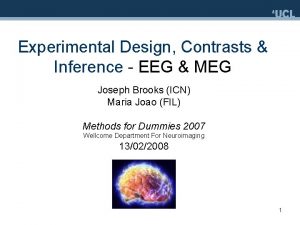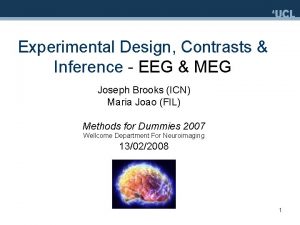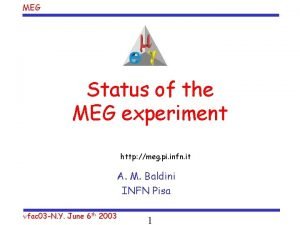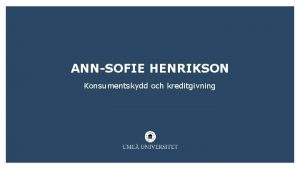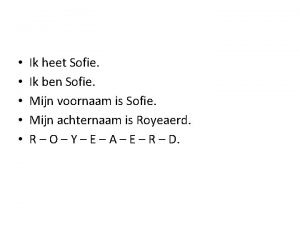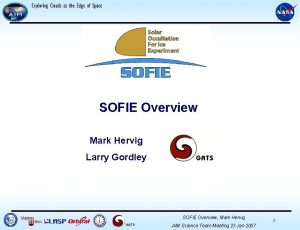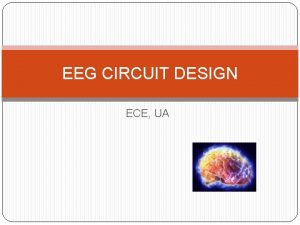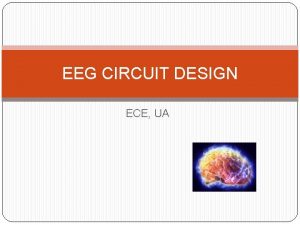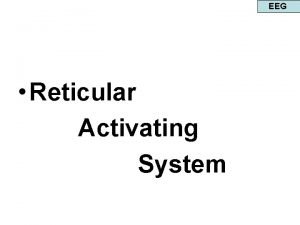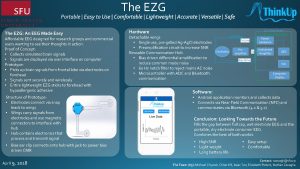EEG MEG Experimental Design Preprocessing Denisa Jamecna Sofie











































- Slides: 43

EEG / MEG: Experimental Design & Preprocessing Denisa Jamecna Sofie Meyer (Archy de Berker(

Outline Experimental Design Preprocessing in SPM 12 • f. MRI M/EEG • Analysis • • – Oscillatory activity – EP • • Design Inferences Limitations Combined Measures Data Conversion Montage Mapping Epoching Downsampling Filtering Artefact Removal Referencing

Combining Techniques- Why? • Converging evidence – Combination of different information from different experiments

Combining Techniques- Why? • Converging evidence – Combination of different information from different experiments • Generative models – Establish generative models for which parameters are estimated from data of different nature. • Using f. MRI data as a prior for MEG source reconstruction • Or M/EEG as regressors for f. MRI….

Combining Techniques f. MRI & M/EEG are complimentary • BOLD activity can occur without M/EEG.

Combining Techniques f. MRI & M/EEG are complimentary • BOLD activity can occur without M/EEG. • M/EEG activity can occur in the absence of BOLD

Combining Techniques f. MRI & M/EEG are complimentary • BOLD activity can occur without M/EEG. • M/EEG activity can occur in the absence of BOLD • Spatial incongruence

Combining Techniques - remember f. MRI & M/EEG are complimentary • BOLD activity can occur without M/EEG. • M/EEG activity can occur in the absence of BOLD • Spatial incongruence • Play to their strengths!

Simultaneous EEG/FMRI

Simultaneous EEG/FMRI • Interleaved / continuous

Simultaneous EEG/FMRI • Interleaved / continuous • Setup – Silver chloride / gold electrodes – Thin carbon fibre / copper wires – Digitize, then use fibre-optic cable

Simultaneous EEG/FMRI • Interleaved / continuous • Setup – Silver chloride / gold electrodes – Thin carbon fibre / copper wires – Digitize, then use fibre-optic cable • Precise localisation of unusual EEG events e. g. interictal events in epilepsy

Technical M/EEG Considerations • Amplifier and filter settings – 50 Hz Notch – Gain of 10 000

Technical M/EEG Considerations • Amplifier and filter settings – 50 Hz Notch – Gain of 10 000 • Sampling frequency

Outline Experimental Design Preprocessing in SPM 12 • f. MRI M/EEG • Analysis • • – Oscillatory activity – EP • • Design Inferences Limitations Combined Measures Data Conversion Montage Mapping Epoching Downsampling Filtering Artefact Removal Referencing

PREPROCESSING • Goal: get from raw data to averaged ERP (EEG) or ERF (MEG) using SPM 12

Conversion of data • Convert data from its native machine-dependent format to MATLAB based SPM format *. bdf *. bin *. eeg *. mat (data) *. dat (other info)

Conversion of data Define settings: • Read data as continuous or as trials (is raw data already divided into trials? ) • Select channels • Define file name • Don’t opt for ‘just read’

Example • 128 channels selected • Unusually flat because data contain very low frequencies and baseline shifts • Viewing all channels only with a low gain *. mat (data) *. dat (other info)

Downsampling • Sampling frequency: very high at acquisition (e. g. 2048 Hz) • Sampling Frequency > 2 x maximum frequency of the signal of interest = The Nyquist frequency


Downsampling • Downsampling reduces the file size and speeds up the subsequent processing steps e. g. 1000 to 200 Hz.

Montage and Referencing • Identify v. EOG and h. EOG channels, remove several channels that don’t carry EEG data.

Montage and Referencing • Identify v. EOG and h. EOG channels, remove several channels that don’t carry EEG data. • Specify reference for remaining channels: • Single electrode reference: free from neural activity of interest • Average reference: Output of all amplifiers are summed and averaged and the averaged signal is used as a common reference for each channel, like a virtual electrode and less biased

Montage and Referencing

Montage and Referencing Review channel mapping

Epoching/splitting into single trials Cut out chunks of continuous data (= single trials, referenced to stim onset) EEG 1 EEG 2 EEG 3 Event 1 Event 2

Epoching/splitting into single trials

Epoching/splitting into single trials • Specify time e. g. 100 ms prestimulus - 600 ms poststimulus = single epoch/trial • Baseline-correction: automatic; mean of the prestimulus time is subtracted from the whole trial • Padding: adds time points before and after each trial to avoid ‘edge effects’ when filtering

Filtering • EEG data consist of signal and noise

Filtering • EEG data consist of signal and noise • Noise of different frequency; filter it out

Filtering • EEG data consist of signal and noise • Noise of different frequency; filter it out • Non-neural physiological activity (skin/sweat potentials); drifts – high pass filter takes care of that; noise from electrical outlets (bandstop around 50/60 Hz)

Filtering • EEG data consist of signal and noise • Noise of different frequency; filter it out • Non-neural physiological activity (skin/sweat potentials); drifts – high pass filter takes care of that; noise from electrical outlets (bandstop around 50/60 Hz) • SPM 12: Butterworth filter • High-, low-, band-pass or bandstop filter


Filtering

Artefacts

Artefact Removal EASY • Removal • Hand-picked • Automatic SPM functions: • Thresholding (e. g. 200 μV) • 1 st – bad channels, 2 nd – bad trials • No change to data, just tagged

Artefact Removal EASY • Removal • Hand-picked • Automatic SPM functions: • Thresholding (e. g. 200 μV) • 1 st – bad channels, 2 nd – bad trials • No change to data, just tagged • Robust averaging: estimates weights (0 -1) indicating how artefactual a trial is

Artefact Removal HARDER • Use your Eo. G! • Regress out of your signal

Artefact Removal HARDER • Use your Eo. G! • Regress out of your signal • Use Independent Component Analysis (ICA) • Eyeblinks are very stereotyped and large • Usually 1 st component


Special thanks to our expert Vladimir Litvak (and apologies to Sofie for any muck-ups on my part)

References • • • Ashburner, J. et al. (2010). SPM 8 Manual. http: //www. fil. ion. ucl. ac. uk/spm/ Hansen, C. P. , Kringelbach M. L. , Salmelin, R. (2010) MEG: An Introduction to Methods. Oxford University Press, Hermann, C. et al. (2004). Cognitive functions of gammaband activity: memory match and utilization. Trends in Cognitive Science, 8(8), 347 -355. Herrmann, C. S. , Grigutsch, M. , & Busch, N. A. (2005). EEG oscillations and wavelet analysis. In T. C. Handy (Ed. ), Event-related potentials: A methods handbook (pp. 229259). Cambridge, MA: MIT Press. Luck, S. J. (2005). Ten simple rules for designing ERP experiments. In T. C. Handy (Ed. ), Event-related potentials: a methods handbook. Cambridge, MA: MIT Press. Luck, S. J. (2010). Powerpoint Slides from ERP Boot Camp Lectures. http: //erpinfo. org/Members/ldtien/bootcamp-lecture-pptx Otten, L. (2012, November 21). EEG/MEG Acquisition, Analysis and Interpretation, MSc Cognitive Neuroscience, UCL Otten, L. J. & Rugg, M. D. (2005). Interpreting event-related brain potentials. In T. C. Handy (Ed. ), Event-related potentials: a methods handbook. Cambridge, MA: MIT Press. . Sauseng, P. , & Klimesch, W. (2008). What does phase information of oscillatory brain activity tell us about cognitive processes? [Review]. Neuroscience and Biobehavioral Reviews, 32(5), 1001 -1013. doi: 10. 1016/j. neubiorev. 2008. 03. 014 http: //sccn. ucsd. edu/~jung/artifact. html Mf. D slides from previous years
 Eeg meg
Eeg meg Experimental vs nonexperimental research
Experimental vs nonexperimental research Experimental vs non experimental
Experimental vs non experimental Descriptive studies
Descriptive studies Disadvantages of experimental research
Disadvantages of experimental research Experimental vs non experimental
Experimental vs non experimental Emg artifact on eeg
Emg artifact on eeg Sofie de broe
Sofie de broe Sofie lameire
Sofie lameire Advantages and disadvantages of phytomining
Advantages and disadvantages of phytomining Udspændthed
Udspændthed Antonie zacpalová
Antonie zacpalová Avtale eksempel
Avtale eksempel Sofie cedstrand
Sofie cedstrand Sofie van hecke
Sofie van hecke Anna khotyanovskaya
Anna khotyanovskaya Sofie thiel
Sofie thiel Sofie thiel
Sofie thiel Alice ann laidlaw
Alice ann laidlaw Toukovuoren palvelukoti
Toukovuoren palvelukoti Vad är dysfunktionella tankar
Vad är dysfunktionella tankar Vzory stredného rodu
Vzory stredného rodu Denisa predeteanu cv
Denisa predeteanu cv Denisa osinova
Denisa osinova Denisa vinanska
Denisa vinanska Denisa osinova
Denisa osinova Denisa vinanska
Denisa vinanska Denisa predeteanu
Denisa predeteanu Tamara ionescu
Tamara ionescu Denisa gottvaldova
Denisa gottvaldova Denisa červenková
Denisa červenková Text preprocessing steps
Text preprocessing steps Text operations
Text operations Outlier
Outlier Etl in data cleaning and preprocessing stands for
Etl in data cleaning and preprocessing stands for Data preprocessing
Data preprocessing Image preprocessing
Image preprocessing Image preprocessing
Image preprocessing Data preparation and preprocessing
Data preparation and preprocessing Data preprocessing
Data preprocessing Neural network data preprocessing
Neural network data preprocessing Preprocessing fem
Preprocessing fem Major tasks in data preprocessing
Major tasks in data preprocessing Preprocessing in image processing
Preprocessing in image processing
